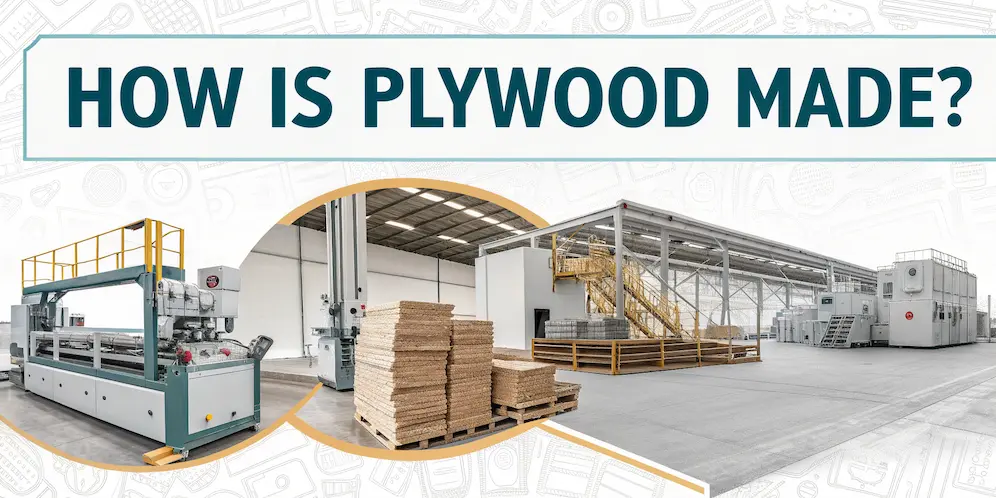Wood is a versatile and widely used material in construction, furniture making, and interior design. But how is plywood manufactured? Understanding the process behind production helps you appreciate its strength, durability, and diverse applications.
In this blog, we’ll explore how plywood is manufactured, from the selection of raw materials to the final pressing and finishing stages.
The Process Behind Crafting Quality Plywood
The art of working with wood and giving its final touch to construct of beautiful home is both intricate and precise. Here’s a step-by-step guide, on how to shape wood that can be used for construction.
1. Selecting The Timber
The plywood manufacturing process begins with selecting the right timber. Common wood species used include hardwoods like oak, birch, and maple, as well as softwoods like pine and fir.
The logs are typically selected based on their size, quality, and moisture content, ensuring they meet the required standards for veneer production.
2. Debarking The Logs
Once the timber is selected, the logs are debarked to remove the outer bark. This step is crucial because it prepares the logs for the next stage, which is peeling or slicing the veneers. Debarking also ensures that the logs are free of impurities that could affect the quality of the final product.
3. Conditioning The Logs
Conditioning the logs is an important step in how plywood is manufactured. The logs are soaked in hot water or steamed to soften the wood, making it easier to peel into thin veneers. This process also helps reduce the chances of the veneers cracking during the peeling process. The temperature and duration of conditioning depend on the type of wood and its moisture content.
4. Peeling The Veneers
After conditioning, the logs are peeled into thin layers, known as veneers. This is done using a rotary lathe, which spins the log against a sharp blade, peeling off a continuous sheet of wood veneer. The thickness of the veneers can vary, but it typically ranges from 1mm to 3mm. The peeled veneers are then cut into sheets of the desired size, ready for further processing.
5. Drying The Veneers
The next step in how plywood is manufactured involves drying the veneers. The freshly cut veneers contain a significant amount of moisture, which must be reduced to prevent warping and ensure proper bonding in the later stages.
The veneers are passed through a drying machine, where hot air is circulated to remove excess moisture. The goal is to achieve an optimal moisture content, usually around 6-10%.
6. Sorting And Grading The Veneers
Once dried, the veneers are sorted and graded based on their quality. Grading is an essential part of the manufacturing process, as it determines the final product’s appearance and strength. High-quality veneers with fewer defects are used for the outer layers of the plywood, while lower-grade veneers may be used for the inner layers.
7. Gluing The Veneers
Gluing is a critical step in how plywood is manufactured. The veneers are coated with a strong adhesive, typically a synthetic resin like phenol-formaldehyde or urea-formaldehyde. The type of adhesive used depends on the intended application of the wood.
For example, marine plywood uses waterproof adhesives to ensure it can withstand exposure to moisture. The adhesive is applied evenly across the veneers to ensure a strong bond between the layers.
8. Assembling The Planking Sheets
After gluing, the veneers are stacked in layers, with the grain of each layer running perpendicular to the one below it. The number of layers, or plies, used depends on the desired thickness and strength of the wood veneer consisting of three to seven layers, but specialty plywood can have more.
9. Pressing The Plywood
The assembled planking sheets are then pressed under high pressure and temperature. This pressing process is a crucial part of how plywood is manufactured, as it bonds the veneers together and ensures a uniform thickness across the sheet. The pressure also helps eliminate air pockets, which could weaken the log. The temperature used during pressing can range from 120°C to 150°C, depending on the adhesive.
10. Trimming and Sanding
Once the log sheets are pressed and cooled, they are trimmed to the desired dimensions. Trimming removes any irregular edges and ensures that the sheets meet the required size specifications. After trimming, the log sheet is sanded to create a smooth surface, ready for further finishing or direct use.
11. Quality Inspection
Quality inspection is a vital step in how wood sheets are manufactured. Each sheet is carefully inspected for defects such as voids, splits, or delamination. The wood log is also tested for its strength, moisture content, and adhesive bonding. Only sheets that pass these quality checks are sent for final finishing and packaging.
12. Finishing and Packaging
The final step in the plywood manufacturing process is finishing and packaging. Depending on the end-use, may be treated with additional finishes, such as laminates, veneers, or coatings, to enhance its appearance and durability. The finished wood sheets are then packaged and labeled for distribution.
Conclusion
Understanding how plywood is manufactured reveals the complexity and precision involved in producing this versatile material. From selecting the right timber to the final quality checks, each step in the process ensures that the plywood meets the required standards of strength, stability, and appearance.
Whether used in construction, furniture making, or interior design, plywood’s manufacturing process is key to its widespread applications and reliability.
Frequently Asked Questions? (FAQs)
What Thicknesses Are Available In Manufactured Plywood?
Plywood comes in various thicknesses, typically ranging from 3mm to 25mm, catering to different construction needs.
What Materials Are Used In Plywood Manufacturing?
Plywood is made from wood veneers, typically bonded with synthetic resins like phenol-formaldehyde or urea-formaldehyde.
How Many Layers Does Plywood Typically Have?
Plywood usually has three to seven layers, but specialty plywood can have more.
What Is The Purpose Of Drying The Veneers In Plywood Manufacturing?
Drying the veneers reduces moisture content, preventing warping and ensuring proper bonding.

